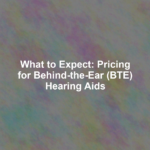When you walk into an audiologistG??s office and see the sleek new line of BTE hearing aids, youG??re looking at a spectrum of prices that can start from a few hundred dollars and soar to several thousand.
As someone considering this investment, youG??re faced with a variety of factors that contribute to these costs, such as technological advancements, brand reputation, and additional features like Bluetooth connectivity or noise reduction capabilities.
You might find the range of prices and options overwhelming, but thereG??s a logical framework to understanding why these devices are priced the way they are. By breaking down the specifics, you can pinpoint where your needs align with what the market offers.
ItG??s essential to grasp what dictates the price of BTE hearing aids to ensure that you make an informed choice that fits both your hearing needs and your budget. Stay with me as we explore the intricacies behind these costs, and IG??ll guide you through making a decision thatG??s sound for both your ears and your finances.
Basics of BTE Hearing Aids
BTE, or Behind-The-Ear hearing aids, are a common type of hearing device designed to sit comfortably behind your ear while amplifying sounds. YouG??ll find that their design separates them into two main parts: the case and the earpiece. The case, which houses the electronics, rests behind your ear, and a clear plastic tube connects it to the earpiece that fits in your ear canal. This setup is known for its durability and ease of handling, making it a go-to choice for individuals of all ages, particularly for those with dexterity concerns.
YouG??ll appreciate that BTE aids are versatile, suiting a wide range of hearing losses, from mild to profound. TheyG??re also larger than in-the-ear models, which often means they can pack in more features, like directional microphones and telecoils. Plus, their size makes them easier to clean and maintain.
When youG??re considering a BTE hearing aid, youG??re looking at a range of prices. The cost can be influenced by the technology level, with more advanced features like wireless connectivity and programmable settings bumping up the price. Remember, investing in your hearing health is crucial, so consider both function and budget when selecting your BTE hearing aid.
Factors Affecting BTE Prices
When considering the cost of Behind-The-Ear hearing aids, itG??s crucial to understand the various factors that can influence their price. YouG??ll find that technology level is a major determinant. Higher-end models boasting advanced features like Bluetooth connectivity, rechargeability, and noise-cancellation technology will set you back more. ItG??s a case of getting what you pay forG??enhanced comfort and better sound quality often come with a heftier price tag.
YouG??ve also got to factor in the brand reputation and market position. Established brands with a history of reliability and customer satisfaction tend to charge more. DonG??t forget, the price can reflect the research and development that goes into creating more sophisticated devices.
Your personal hearing needs play a role, too. If you have severe hearing loss, you might need a more powerfulG??and consequently, more expensiveG??model. And itG??s not just about the device itself; professional services such as a hearing test, fitting, and follow-up adjustments contribute to the overall cost.
Lastly, consider the warranty and aftercare services offered. A longer warranty period or inclusive aftercare can mean higher upfront costs, but theyG??ll save you money on potential repairs or adjustments down the line. ItG??s about balancing immediate costs against long-term value.
Analyzing the Cost Spectrum
Understanding these factors that mold BTE hearing aid prices, letG??s now explore the cost spectrum these devices span, from budget-friendly options to premium models. YouG??ll find that BTE hearing aids can vary greatly in price, and this range is influenced by several parameters including technology, features, and brand reputation.
HereG??s a breakdown to help you navigate the cost spectrum:
-
Budget-Friendly Options ($500 – $1,000)
-
Basic sound amplification
-
Limited programmability
-
Fewer features and customization options
-
Mid-Range Models ($1,000 – $3,000)
-
Advanced noise reduction capabilities
-
Wireless connectivity with smartphones or other devices
-
Some degree of customization and environmental adaptability
-
Premium Models ($3,000 – $6,000+)
-
Cutting-edge technology with superior sound quality
-
Extensive customization to individual hearing loss profiles
-
Additional features like rechargeability, tinnitus masking, and biometric monitoring
Tips for Cost-Effective Shopping
To maximize your investment in a BTE hearing aid, itG??s crucial to shop smartly and consider both value and functionality. Start by researching and comparing different brands and models. Look for reviews from other users and consult with your audiologist for recommendations tailored to your specific needs.
DonG??t overlook the importance of after-sales service and warranty. A cheaper upfront cost can end up more expensive if youG??re paying for repairs or replacements down the line. Find out whatG??s included in the price, such as follow-up fittings, routine cleanings, and adjustments.
Consider financing options or payment plans if the upfront cost is daunting. Some retailers offer interest-free periods or discounts for upfront payments. Also, check if your insurance plan covers any costs associated with hearing aids.
Lastly, watch for promotions and discounts. Manufacturers often offer seasonal sales or rebates on older models when new ones are released. Signing up for newsletters or alerts from hearing aid providers can keep you informed about upcoming deals.
Navigating Insurance and Assistance Programs
Often, insurance coverage can significantly reduce the cost of BTE hearing aids, so itG??s essential to explore your policyG??s benefits thoroughly. DonG??t hesitate to contact your insurance provider to clarify whatG??s included. You may find coverage varies greatly from full, partial, or none at all depending on your plan.
- Check Your Insurance Plan
- Private Insurance: Some plans include hearing aid coverage; review your specific benefits.
- Medicare: Generally doesnG??t cover hearing aids, but Medicare Advantage plans might offer some benefits.
- Medicaid: Coverage can vary by state, with some providing full or partial coverage for BTE hearing aids.
If your insurance falls short, look into assistance programs that could help bridge the gap.
- Assistance Programs
- State Programs: Many states offer assistance, especially for children or low-income individuals.
- Non-Profit Organizations: Organizations like the Hearing Loss Association of America provide resources and might offer financial aid.
- Veterans Affairs: If youG??re a veteran, you may qualify for hearing aids at no cost through the VA.
Conclusion
You now grasp the essentials of BTE hearing aids and what drives their prices. Whether youG??re eyeing the most advanced options or hunting for a bargain, smart shopping strategies can make a difference.
DonG??t forget to explore insurance and assistance programs that might ease the financial burden. With this knowledge, youG??re better equipped to find a hearing aid that fits both your needs and your budget.
Remember, investing in your hearing is investing in your quality of life.









